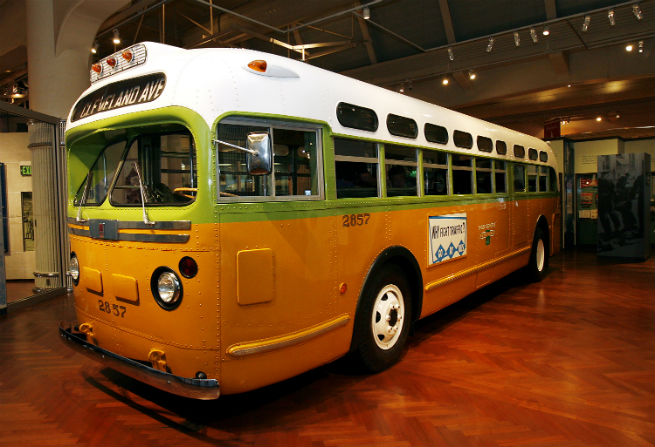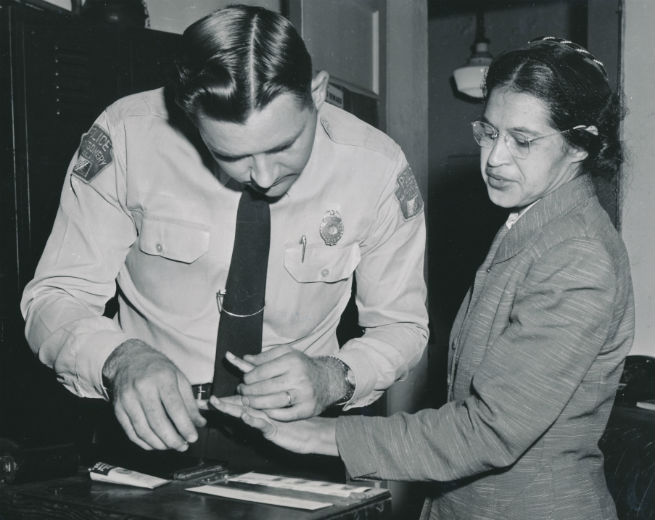This bus was built in 1948 by General Motors. It's famous not for where it went, or the route it ran, but for what happened upon it.

On 1 December 1955, Rosa Parks was returning from work when she boarded the bus. America was a nation in which racial segregation was not only prevelant, but had been given legal blessing. African Americans were obliged to travel at the back of Alabama buses and Rosa, dutifully, walked down the bus to sit in the area allowed for passengers who were not white. The bus continued to fill, though, and the driver, J Fred Blake, ordered those sitting at the front of the "colored section" to move down further still, so that white customers could have those seats, too.
Rosa Parks sat tight.
The police were called; Rosa was arrested.
 Rosa Parks being fingerprinted
Rosa Parks being fingerprinted
She wasn't the first person to have been arrested in Montgomery for refusing to give up seats - Claudette Colvin, a fifteen year old girl, had been convicted for refusing to give up her seat to a white person earlier in the year. Claudette's case had already created a desire by some civil rights activists to have a boycott of the buses - most notably within the Women's Political Council. Their leader Jo Ann Robinson saw Rosa's treatment as the moment to act:
The Women’s Political Council will not wait for Mrs. Parks’s consent to call for a boycott of city buses. On Friday, December 2, 1955, the women of Montgomery will call for a boycott to take place on Monday, December 5
A flier was printed and distributed:
Another Negro woman has been arrested and thrown in jail because she refused to get up out of her seat on the bus for a white person to sit down. It is the second time since the Claudette Colvin case that a Negro woman has been arrested for the same thing. This has to be stopped. Negroes have rights, too, for if Negroes did not ride the buses, they could not operate. Three-fourths of the riders are Negroes, yet we are arrested, or have to stand over empty seats. If we do not do something to stop these arrests, they will continue. The next time it may be you, or your daughter, or mother. This woman’s case will come up on Monday. We are, therefore, asking every Negro to stay off the buses Monday in protest of the arrest and trial. Don’t ride the buses to work, to town, to school, or anywhere on Monday. You can afford to stay out of school for one day if you have no other way to go except by bus. You can also afford to stay out of town for one day. If you work, take a cab, or walk. But please, children and grown-ups, don’t ride the bus at all on Monday. Please stay off all buses Monday.
The bus boycott started to take on a life of its own, spreading from one day - and with a set of coherent demands. Martin Luther King gave his blessing:
In his memoir, Stride Towards Freedom, Martin Luther King tabulates the original aims:
(1) courteous treatment by the bus operators was guaranteed; (2) passengers were seated on a first-come, first-served basis – Negroes seating from the back of the bus toward the front while whites seated from the front toward the back; (3) Negro bus operators were employed on predominantly Negro routes
As the boycott continued, though, support for the protest saw the demands coalesce into one single rallying cry: no segregation on the buses.
Montgomery's mayor Gayle dug in his heels. He stated:
We are going to hold our stand. We are not going to be a part of any program that will get Negroes to ride the buses again at the price of the destruction of our heritage and way of life
It became clear that this was going to be a question that needed a legal solution, and so the protestors took their case to court:
On June 5, the special panel ruled two to one in favor of the black plaintiffs. Rives’ majority opinion in which Johnson concurred held that the 1954 Brown ruling, which had overturned the 1896 Plessy v. Ferguson ,”separate but equal” doctrine, applied not only to public schools but to other forms of legalized segregation, including public transportation. The three-judge panel delayed enforcement of its ruling until the city had exhausted its appeals.
It was not until the US Supreme Court had heard the case - and again sided with the protestors - that the bus boycott ended. After 381 days, on 20 December 1956, black Americans once again rode the buses of Montgomery. But this time, they chose where to sit. Segregation was one stop further along the road to history.
Rate and Review
Rate this article
Review this article
Log into OpenLearn to leave reviews and join in the conversation.
Article reviews